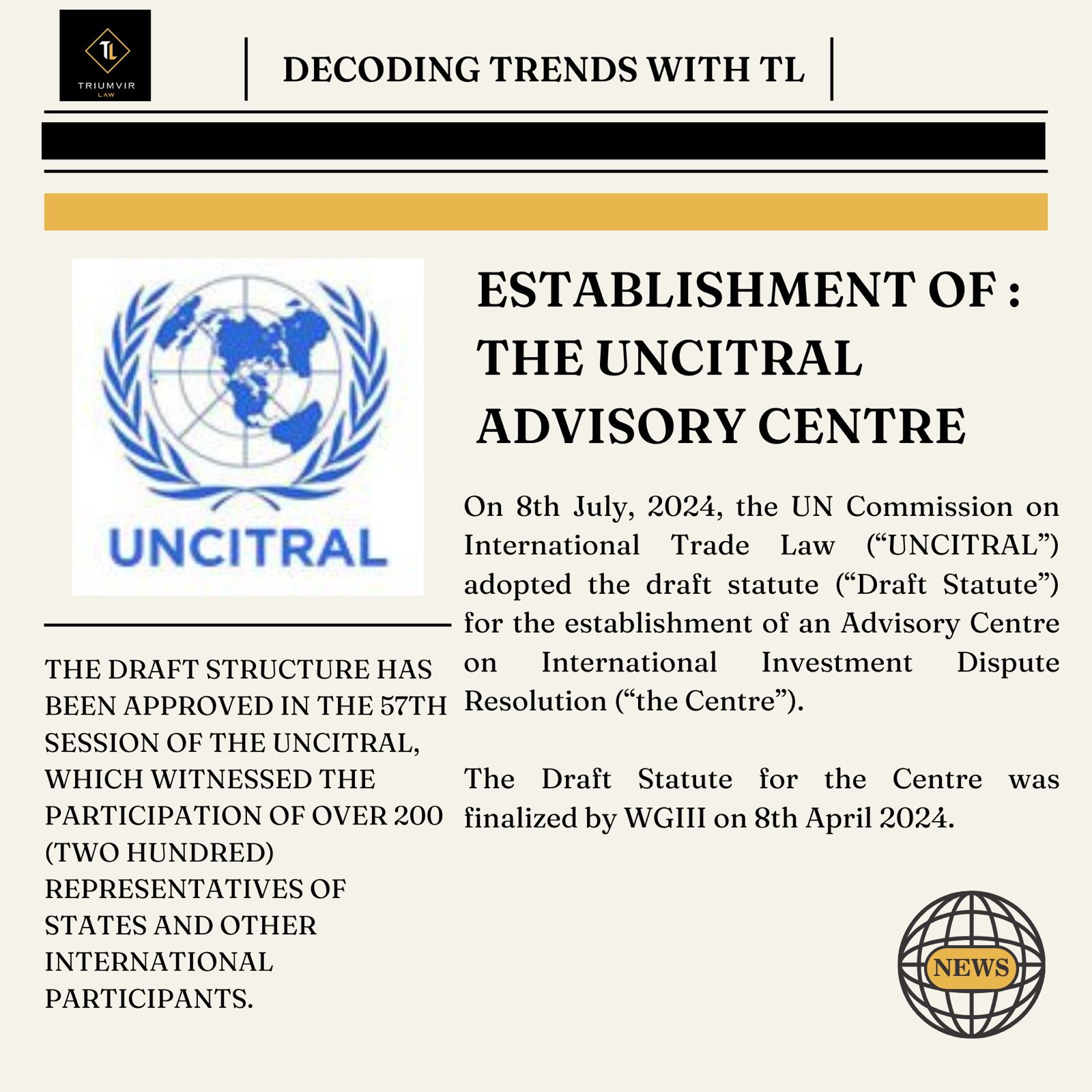
Decoding Trends With Trumvir Law

The Jurisprudence of Anti-Arbitration Injunctions in India
- March 13, 2024
- Decoding Trends With Triumvir Law
- Paras Joshi
As arbitration increasingly becomes the preferred method of dispute resolution in India, the arbitration regime and the jurisprudence have seen marked development. For instance, the last two decades witnessed multiple amendments to the Arbitration and Conciliation Act, 1996 (“Act”). The Courts have also rendered numerous judgments aimed at strengthening the arbitral framework in India. These judgments have collectively reaffirmed the principle of Kompetenz-Kompetenz as well as stressed on minimal interference of the Courts to the arbitral process.
In this background, two recent decisions of the Bombay and Delhi High Courts effectively staying arbitration proceedings before two separate arbitration institutions seem to be an outlier to these trends. In the first decision, the Bombay High Court and the NCLT Bombay restrained a Singapore-based PE firm from relying upon a Singapore seated arbitration agreement in an SHA signed with an Indian party on the ground that shareholders disputes are not arbitrable in India. More recently, the Delhi High Court restrained the Respondents from proceeding in an international commercial arbitration on the ground that the parties to the dispute were yet to mutually decide the place of the arbitration as required by the arbitration agreement.
Such injunctive suits, designed to prevent the initiation or restrain the continuation of arbitration proceedings, are called anti-arbitration injunctions (“AAI”). An AAI is generally sought before arbitration commences or in the course of the arbitration hearing or after the conclusion of the substantive hearing but before the rendering of the final award. Such injunctions are mostly issued when there is a dispute about the existence of a legally enforceable arbitration clause or the jurisdiction of the tribunal, however, that is not always the case.
Naturally, there are conflicting views about the efficacy and desirability of AAIs in the arbitration community. Proponents argue that if there is no valid arbitration agreement, it is not conducive to force parties to go through the arbitration proceedings only for the same to be challenged before a Court at a later stage. They also point to Article 8 of the UNCITRAL Model Law and Article II of the New York Convention to support their argument that Courts ought to step in if there are questions about the validity of the agreement or jurisdiction of the tribunals.
On the other hand, critics argue that AAIs are in the teeth of the principle of Kompetenz-Kompetenz. They characterise AAIs as a deliberate obstructionist method to pursue local courts to interfere with the mutually agreed dispute resolution mechanism. This conflict, they argue, strikes at the very heart of the intention behind choosing arbitration as the method of dispute resolution.
The statutory basis for granting AAIs in India
Globally, there is no uniformity in the statutory and jurisprudential recognition of AAIs. In India, Section 16 of the Act codifies the principle of Kompetenz-Kompetenz, thus empowering the tribunals to deal with any challenge concerning the validity of the arbitration agreement or their own jurisdiction. The non-obstante clause in section 5 further restrains judicial authority from intervening in arbitration proceedings save for the method prescribed under the act. Regardless, courts seem to have been provided with the power to examine the existence of a valid arbitration agreement under Section 8 of the Act. A joint reading of these sections can help one to cull out the grounds, albeit limited, on which a court may intervene in arbitration proceedings, or refuse to refer parties to arbitration, as the case may be;
however, there is no clarity on the question of granting an anti-arbitration injunction under
the Act. The dichotomy between the scope of a Court’s power under section 8 and the principle of minimal interference under sections 5 and 16 seems to provide the basis for the issuance of AAIs.
Judicial Engagement with AAIs
The issue of granting anti-arbitration injunctions in India has been a recurrent theme in judicial discourse, leading to an evolving jurisprudence that remains inconclusive. Supreme Court in the landmark case of Kvaerner Cementation India Ltd. v. Bajranglal Agarwal laid the foundation by asserting that civil courts lack the authority to determine the jurisdiction of arbitration tribunals, emphasizing the need for minimal judicial intervention in arbitration matters. Chatterjee Petrochem Co. v. Haldia Petrochemicals Ltd further expanded the proposition to hold AAI are not maintainable given Section 5.
However, the landscape becomes intricate with divergent views emerging in subsequent decisions. While some judgments, like SBP & Co. v. Patel Engineering appear to partially overrule Kvaerner Cementation, the judgment in World Sport Group established the Court’s jurisdiction to injunct arbitration proceedings under Section 45 of the Act.
The Calcutta High Court, in The Board of Trustees of the Port of Kolkata v. Louis Dreyfus Armatures SAS , adopted this stance by asserting the courts’ authority to grant anti-arbitration injunctions under specific circumstances outlined in Sections 8 and 45 of the Act.
Subsequently, the principle of minimal interference and primacy of Kompetenz-Kompetenz was restored by the Supreme Court in cases such as A. Ayyasamy v. A. Paramasivam and National Aluminium Co. Ltd. (NALCO) v. Subhash Infra Engineers (P) Ltd.; emphasizing the Arbitral Tribunal’s authority to rule on its jurisdiction.
Notwithstanding, conflicting interpretations persist at the High Court level, as seen in the Delhi High Court’s stance in McDonald’s India (P) Ltd. vs Vikram Bakshi , which aligns with the idea that civil courts have jurisdiction to grant anti-arbitration injunctions under compelling circumstances. Conversely, the Delhi High Court’s decision in Bina Modi v. Lalit Kumar Modi emphasizes the Kompetenz-Kompetenz principle, stating that the Civil Court lacks the power to grant such injunctions, aligning with Kvaerner Cementation and NALCO. The conflicting views are further highlighted in the ADM International Sarl v. Sunraja Oil Industries (P) Ltd, where the Madras High Court laid out stringent conditions for granting anti-arbitral injunctions. The court emphasized that demonstrating the nullity, voidness, inoperability, or incapability of the performance of the arbitration agreement is a prerequisite, and mere bias in the arbitral institution is insufficient for an injunction.
The need for clarity in this evolving jurisprudence is therefore evident. The judgment in Bina Modi by the Delhi High Court supports the idea that the Civil Court should not intervene, whereas the Calcutta High Court’s perspective in Balasore Alloys Ltd. v. Medima LLC contradicts this, asserting Indian Courts’ jurisdiction to grant anti-arbitration injunctions. This discrepancy highlights the ambiguity in the legal landscape and emphasizes the requirement for a more consistent and uniform approach.
Conclusion
The conflicting interpretations by High Courts highlight the lack of uniformity in the jurisprudence surrounding AAIs. The divergence in decisions among High Courts on AAI stems from the conflicting opinions within the apex court, creating a scenario where High Courts are left to choose between contrasting positions. The Supreme Court’s emphasis on arbitration-friendly decisions, coupled with the limited circumstances for granting injunctions, contrasts sharply with the diverse but nuanced approaches taken by High Courts. The overall trend seems to lean towards maintaining the sanctity of arbitration agreements save only in exceptional circumstances that mandate court interference. Notwithstanding, there is a pressing need for clarity and coherence in addressing the divergence in opinion. The question of whether to exclude judicial intervention entirely in favour of the tribunal’s decision-making power arises, yet, a blanket exclusion may not be the solution. What is required is a clear delineation of grounds on which such power may be exercised. In conclusion, the evolving legal landscape surrounding AAIs in India warrants a thorough examination and possible refinement to ensure a harmonized approach across jurisdictions. The delicate equilibrium between arbitration autonomy and judicial oversight needs preservation, and a more authoritative and nuanced approach towards granting AAIs is the need of the hour.
RECENT POST
SOCIAL SHARE
Related Post

Budget Takeaways 2024-25
Decoding Trends With Trumvir Law The Budget for FY 2024-2025, presented on July 23, 2024, aims to advance India’s growth

The Transformation of Criminal Law in India: A Comprehensive Overview
Decoding Trends With Trumvir Law India’s legal landscape witnessed a seismic shift on July 1, 2024, with the introduction of

Empowering Arbitration: The Advisory Centre on International Dispute Resolution
Decoding Trends With Trumvir Law I. Introduction On 8th July, 2024, the UN Commission on International Trade Law (“UNCITRAL”) adopted

